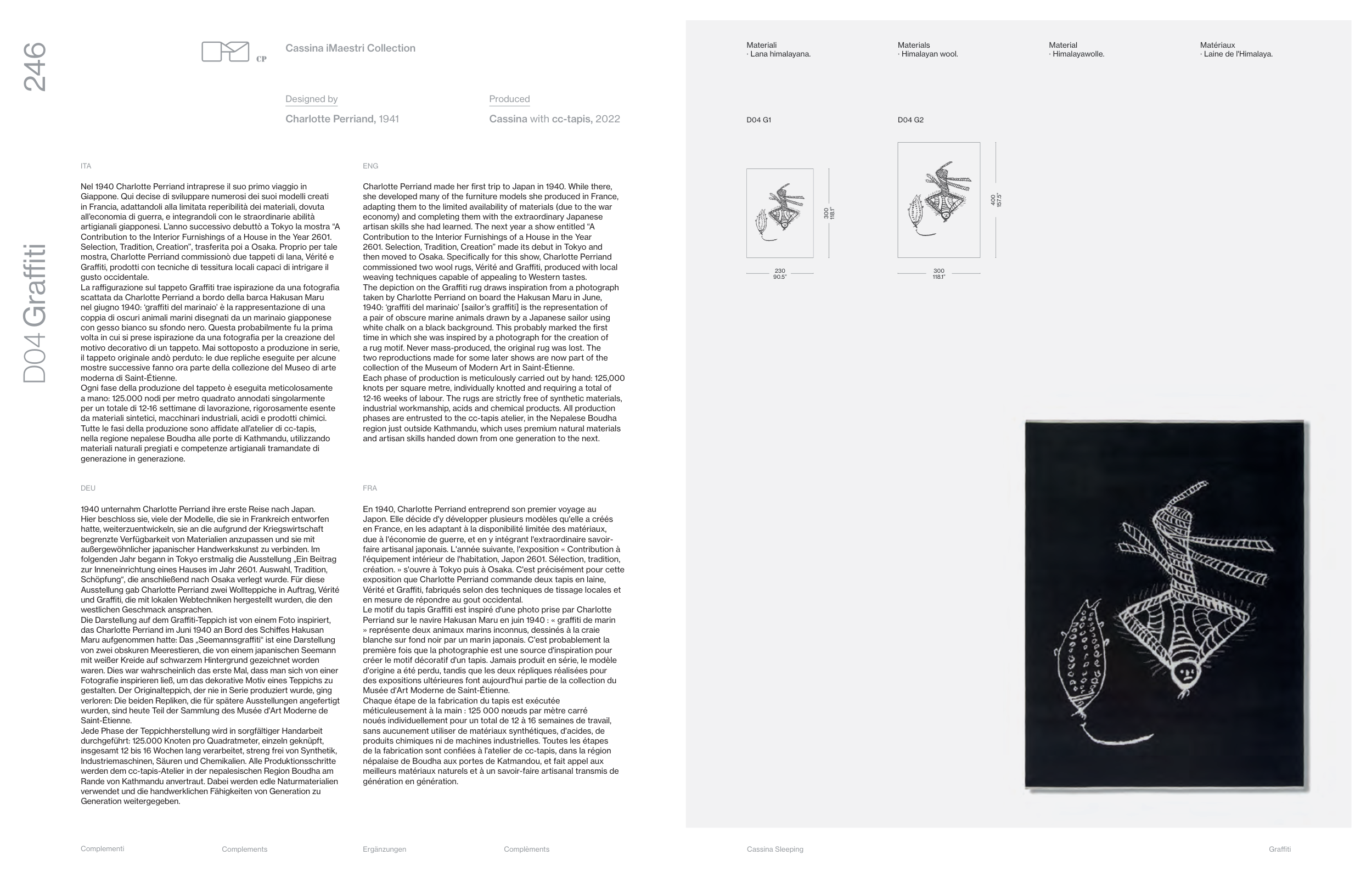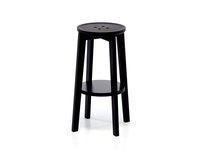Graffiti
Cassina Sleeping
246
Complèments
Ergänzungen
Complements
Complementi
Materiali
· Lana himalayana.
Material
· Himalayawolle.
Materials
· Himalayan wool.
Matériaux
· Laine de l'Himalaya.
D04 Graffiti
Nel 1940 Charlotte Perriand intraprese il suo primo viaggio in
Giappone. Qui decise di sviluppare numerosi dei suoi modelli creati
in Francia, adattandoli alla limitata reperibilità dei materiali, dovuta
all’economia di guerra, e integrandoli con le straordinarie abilità
artigianali giapponesi. L’anno successivo debuttò a Tokyo la mostra “A
Contribution to the Interior Furnishings of a House in the Year 2601.
Selection, Tradition, Creation”, trasferita poi a Osaka. Proprio per tale
mostra, Charlotte Perriand commissionò due tappeti di lana, Vérité e
Graffiti, prodotti con tecniche di tessitura locali capaci di intrigare il
gusto occidentale.
La raffigurazione sul tappeto Graffiti trae ispirazione da una fotografia
scattata da Charlotte Perriand a bordo della barca Hakusan Maru
nel giugno 1940: ‘graffiti del marinaio’ è la rappresentazione di una
coppia di oscuri animali marini disegnati da un marinaio giapponese
con gesso bianco su sfondo nero. Questa probabilmente fu la prima
volta in cui si prese ispirazione da una fotografia per la creazione del
motivo decorativo di un tappeto. Mai sottoposto a produzione in serie,
il tappeto originale andò perduto: le due repliche eseguite per alcune
mostre successive fanno ora parte della collezione del Museo di arte
moderna di Saint-Étienne.
Ogni fase della produzione del tappeto è eseguita meticolosamente
a mano: 125.000 nodi per metro quadrato annodati singolarmente
per un totale di 12-16 settimane di lavorazione, rigorosamente esente
da materiali sintetici, macchinari industriali, acidi e prodotti chimici.
Tutte le fasi della produzione sono affidate all’atelier di cc-tapis,
nella regione nepalese Boudha alle porte di Kathmandu, utilizzando
materiali naturali pregiati e competenze artigianali tramandate di
generazione in generazione.
Charlotte Perriand made her first trip to Japan in 1940. While there,
she developed many of the furniture models she produced in France,
adapting them to the limited availability of materials (due to the war
economy) and completing them with the extraordinary Japanese
artisan skills she had learned. The next year a show entitled “A
Contribution to the Interior Furnishings of a House in the Year
2601. Selection, Tradition, Creation” made its debut in Tokyo and
then moved to Osaka. Specifically for this show, Charlotte Perriand
commissioned two wool rugs, Vérité and Graffiti, produced with local
weaving techniques capable of appealing to Western tastes.
The depiction on the Graffiti rug draws inspiration from a photograph
taken by Charlotte Perriand on board the Hakusan Maru in June,
1940: ‘graffiti del marinaio’ [sailor’s graffiti] is the representation of
a pair of obscure marine animals drawn by a Japanese sailor using
white chalk on a black background. This probably marked the first
time in which she was inspired by a photograph for the creation of
a rug motif. Never mass-produced, the original rug was lost. The
two reproductions made for some later shows are now part of the
collection of the Museum of Modern Art in Saint-Étienne.
Each phase of production is meticulously carried out by hand: 125,000
knots per square metre, individually knotted and requiring a total of
12-16 weeks of labour. The rugs are strictly free of synthetic materials,
industrial workmanship, acids and chemical products. All production
phases are entrusted to the cc-tapis atelier, in the Nepalese Boudha
region just outside Kathmandu, which uses premium natural materials
and artisan skills handed down from one generation to the next.
1940 unternahm Charlotte Perriand ihre erste Reise nach Japan.
Hier beschloss sie, viele der Modelle, die sie in Frankreich entworfen
hatte, weiterzuentwickeln, sie an die aufgrund der Kriegswirtschaft
begrenzte Verfügbarkeit von Materialien anzupassen und sie mit
außergewöhnlicher japanischer Handwerkskunst zu verbinden. Im
folgenden Jahr begann in Tokyo erstmalig die Ausstellung „Ein Beitrag
zur Inneneinrichtung eines Hauses im Jahr 2601. Auswahl, Tradition,
Schöpfung“, die anschließend nach Osaka verlegt wurde. Für diese
Ausstellung gab Charlotte Perriand zwei Wollteppiche in Auftrag, Vérité
und Graffiti, die mit lokalen Webtechniken hergestellt wurden, die den
westlichen Geschmack ansprachen.
Die Darstellung auf dem Graffiti-Teppich ist von einem Foto inspiriert,
das Charlotte Perriand im Juni 1940 an Bord des Schiffes Hakusan
Maru aufgenommen hatte: Das „Seemannsgraffiti“ ist eine Darstellung
von zwei obskuren Meerestieren, die von einem japanischen Seemann
mit weißer Kreide auf schwarzem Hintergrund gezeichnet worden
waren. Dies war wahrscheinlich das erste Mal, dass man sich von einer
Fotografie inspirieren ließ, um das dekorative Motiv eines Teppichs zu
gestalten. Der Originalteppich, der nie in Serie produziert wurde, ging
verloren: Die beiden Repliken, die für spätere Ausstellungen angefertigt
wurden, sind heute Teil der Sammlung des Musée d'Art Moderne de
Saint-Étienne.
Jede Phase der Teppichherstellung wird in sorgfältiger Handarbeit
durchgeführt: 125.000 Knoten pro Quadratmeter, einzeln geknüpft,
insgesamt 12 bis 16 Wochen lang verarbeitet, streng frei von Synthetik,
Industriemaschinen, Säuren und Chemikalien. Alle Produktionsschritte
werden dem cc-tapis-Atelier in der nepalesischen Region Boudha am
Rande von Kathmandu anvertraut. Dabei werden edle Naturmaterialien
verwendet und die handwerklichen Fähigkeiten von Generation zu
Generation weitergegeben.
En 1940, Charlotte Perriand entreprend son premier voyage au
Japon. Elle décide d'y développer plusieurs modèles qu'elle a créés
en France, en les adaptant à la disponibilité limitée des matériaux,
due à l'économie de guerre, et en y intégrant l'extraordinaire savoir-
faire artisanal japonais. L'année suivante, l'exposition « Contribution à
l'équipement intérieur de l'habitation, Japon 2601. Sélection, tradition,
création. » s'ouvre à Tokyo puis à Osaka. C'est précisément pour cette
exposition que Charlotte Perriand commande deux tapis en laine,
Vérité et Graffiti, fabriqués selon des techniques de tissage locales et
en mesure de répondre au gout occidental.
Le motif du tapis Graffiti est inspiré d'une photo prise par Charlotte
Perriand sur le navire Hakusan Maru en juin 1940 : « graffiti de marin
» représente deux animaux marins inconnus, dessinés à la craie
blanche sur fond noir par un marin japonais. C'est probablement la
première fois que la photographie est une source d'inspiration pour
créer le motif décoratif d'un tapis. Jamais produit en série, le modèle
d'origine a été perdu, tandis que les deux répliques réalisées pour
des expositions ultérieures font aujourd'hui partie de la collection du
Musée d'Art Moderne de Saint-Étienne.
Chaque étape de la fabrication du tapis est exécutée
méticuleusement à la main : 125 000 nœuds par mètre carré
noués individuellement pour un total de 12 à 16 semaines de travail,
sans aucunement utiliser de matériaux synthétiques, d'acides, de
produits chimiques ni de machines industrielles. Toutes les étapes
de la fabrication sont confiées à l'atelier de cc-tapis, dans la région
népalaise de Boudha aux portes de Katmandou, et fait appel aux
meilleurs matériaux naturels et à un savoir-faire artisanal transmis de
génération en génération.
ITA
ENG
DEU
FRA
230
90.5”
300
118.1”
300
118.1”
D04 G1
D04 G2
400
157.5”
Designed by
Charlotte Perriand, 1941
Produced
Cassina with cc-tapis, 2022
Cassina iMaestri Collection



